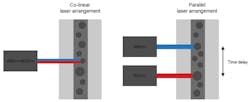Flow Cytometry Part 3: Improving Signal-to-Noise Ratio in Flow Cytometer Optics
Key Takeaways:
- Flow cytometry is a method for studying cells using fluorescent tagging and optical analysis as they flow past a laser.
- Improving the signal-to-noise ratio (SNR) is essential in flow cytometry for reducing background noise and enhancing relevant cell signals, achieved through optimizing optical components.
- Laser performance directly affects SNR, with stable output power and focused beam quality crucial for reducing noise and obtaining accurate data.
Flow Cytometer SNR
In previous articles, we’ve looked at how flow cytometer optics enable cellular phenotyping, and we’ve gone into some detail on the many applications of this optical technique. This article, part three of a three-part series, focuses on a key problem in the field: increasing the signal-to-noise ratio. But before we begin, let’s quickly review just what flow cytometry is. That foundational knowledge will help us understand the challenge of increasing flow cytometer SNR (signal-to-noise ratio).
Quick Review: What is Flow Cytometry?
Flow cytometry is an optical technique used to elucidate details about cells. These cells, tagged with fluorescent compounds, are suspended in a liquid that flows through an ‘interrogation point’. Hydrodynamic focusing forces them to go through ‘single file’, or one after the other. At this point, excitation light sources (typically one or more laser lines) bathe the sample in light. Configuration of the lasers may either be collinear (where the cells are exposed to multiple lasers at one time) or parallel (where laser lines are separated and each cell is affected by only one at a time). Emission from the excited fluorophores as well as side and forward scatter are collected by a detector, converted to a photocurrent, and recorded by the system.
Forward scatter detection is when the lasers point directly at a detector. Side scatter detection, in contrast, involves a side placement of a detector and lenses placed so as to route the side scattered light to the detector.
Understanding Signal to Noise Ratio in Flow Cytometer Optics
When we talk about increasing the signal to noise ratio (SNR), we aren’t just talking about getting stronger fluorescence signals from tagged cells that are passed through a typical flow cytometer setup. What we want is more signal for the amount of random errors: less background and more that matters.
The signal to noise ratio depends on pretty much every part of the flow cytometry apparatus, as well as on experiment setup, sampling techniques, and methods used for staining. Key optical components that affect the SNR include:
- Lasers
- Optical filters (short pass filters, long pass filters, bandpass filters)
- Dichroic Mirrors
- Lenses
- Detectors (Photomultiplier tubes or photodiodes)
Lasers and Flow Cytometer SNR
When setting up your flow cytometry configuration, you’ll have chosen the appropriate wavelength specifications and power for your laser. But there are a few factors that are often overlooked— factors that can make a big difference when it comes to the SNR.
Output power stability: how high are the time dependent variations in your laser output power? Two values define the power stability, or lack thereof: peak to peak (which elucidates sudden, high spikes or deep dips) and root mean square, or rms (which reflects average of variations). Both of these numbers can be considered to be noise readings, and bringing them down is key to bringing down the SNR . When you’re measuring blood cells, for instance, you need to make sure the rms noise is <0.1. Smaller particles will require even less noise, but if you’re studying phytoplankton you can work with a higher rms since the signal will also be higher.
Laser beam quality, or the ability of the laser light to focus well to a small spot, is another parameter you need to pay attention to. This is measured in terms of M2, where a perfect, diffraction-limited beam has a M2 of 1. If you’re working with a laser with M2=3, the laser focus spot will be 2x bigger than the spot of a perfect laser— and, what is worse, it will have a non-Gaussian intensity profile and, most likely, random hot spots. This adds at the same time as lowering the signal power density.
Filters, Mirrors, and Lenses
A chain is as strong as its weakest link, and even the best lasers with optimal output power stability and laser beam quality won’t give you a high SNR if you’re working with subpar optics. Ensure that the bandpass filters, mirrors, and lenses you use in your flow cytometry workflow are manufactured to high standards, and—- just as important— make sure you’re using the right ones. One important parameter is the range of wavelengths for your filters.
For instance, suppose you are counting excitation from FITC and DY-505, with excitation maximums at 495 and 503 and emission maximums at 519 and 530. A laser beam with specific wavelengths of 500 nm would excite both. Two bandpass filters with 525 x 25 nm could be used in front of the two detectors, but the resulting data would be inaccurate and include much double counting. More useful would be the use of a 510 x 10nm bandpass filter and another at 532 x 10 nm.

